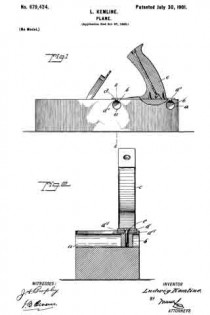No. 679,424 – Plane (Ludwig Kemline) (1901)

UNITED STATES PATENT OFFICE.
_________________
LUDWIG KEMLINE, OF PINOLE, CALIFORNIA.
PLANE.
_________________
SPECIFICATION forming part of Letters Patent No. 679,424, dated July 30, 1901.
Application filed October 27, 1900. Serial No. 34,625. (No model.)
_________________
To all whom it may concern:
Be it known that I, LUDWIG KEMLINE, a citizen of the United States, and a resident of Pinole, in the county of Contra Costa and State of California, have invented a new and Improved Plane, of which the following is a full, clear, and exact description.
The purpose of this invention is to provide a plane or other tool with a handle which may be adjusted transversely of the plane, so as to place the hand of the user in any position desired with respect to the transverse extent of the plane. By these means the operator may avoid bruising his hands or otherwise interfering with the work when it is of such character as will make it inconvenient to use the tool with the handle in the middle thereof.
This specification is the disclosure of one form of the invention, while the claims define the actual scope thereof.
Reference is to be had to the accompanying drawings, forming a part of this specification, in which similar characters of reference indicate corresponding parts in both views.
Figure 1 is a side view of the invention with parts in section, and Fig. 2 is a section on the line 2 2 of Fig. 1.
The plane is constructed in the usual manner, except that the body is formed with two transverse grooves a, which open at the upper side of the body and which are undercut, as shown. The cross-sectional form of the grooves a is immaterial so long as the opening at the top of the grooves is of less width than the opening below the top. The purpose of this is to hold in the grooves the blocks b in such a manner as to prevent the blocks from moving upward or transversely out of the grooves. These blocks are freely movable longitudinally of the grooves, however, and the handle c of the plane is attached to the blocks through the medium of a face-plate d and screws e, passing through the base-plate and into the blocks, as best shown in Fig. 2. The base-plate d is provided with transverse ribs d’, which fit in the upper sides of the grooves a, and serve to assist in holding the base-plate in position. The base-plate is preferably of metal and fastened to the handle c by screws or other devices, as shown.
Having thus described my invention, I claim as new and desire to secure by Letters Patent —
1. A plane or analogous tool having an undercut groove in the upper side thereof, said groove extending transversely of the plane, a block adjustably mounted in the groove, a handle, a base-plate on which the handle is mounted, and a fastening device extending between the base-plate and block to bind the block against the walls of the groove and adjustably hold the handle.
2. A plane or analogous tool having two undercut grooves formed in its upper side, said grooves extending transversely of the plane, a block adjustable in each groove, a base-plate extending from one groove to the other and having ribs fitting in the grooves, fastening devices extending between the block and the base-plate, and a handle fastened to the base-plate.
In testimony whereof I have signed my name to this specification in the presence of two subscribing witnesses.
LUDWIG KEMLINE.
Witnesses:
JAMES SILVAS,
A. McCULLOUGH.


